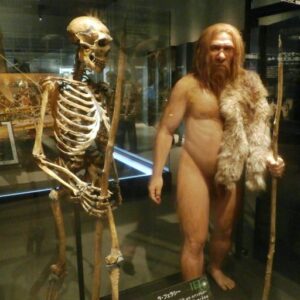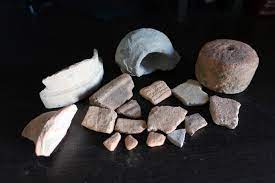When I was in high school, one of my favorite subjects was history. While it was important to memorize dates as well as the names of important people and places, a stronger emphasis was placed on understanding how and why certain events happened. Through a collection of primary, secondary, and tertiary sources, we tried to accurately piece together events from decades (or centuries) ago; however, it was not always possible to gain a full understanding of every historical event. The further back in time we went, the harder it was to find first-hand sources, and the loss of contextual information became larger. Furthermore, the amount of information that had to be retained left little room for diving deeply into the source material.
By the time I left school I realized that there was so much more to learn about what has happened in the past, so I relished times where history and science dovetailed to give more context clues. Some scientists have tried to make better sense of inexplicable historical phenomena; for example, while the events of the Salem Witch Trials have been pored over by numerous textbooks and have become dramatized in works such as The Crucible, one area of mystery was what caused the symptoms of the witchcraft such as convulsions and hallucinations. Though it is often chalked up to “mass hysteria”, I later learned that scientists have drawn comparisons between the symptoms the afflicted had to those who have consumed ergot (a rye fungus), and that it could be applied to other historical records of mass delusions such as the dancing plague of 1518. Other scientific works have tried to paint a clearer picture of what has happened over a long period of time; for example, anthropologists have analyzed the ratios of different isotopes (versions of chemical elements with different numbers of neutrons but the same properties) in samples such as tooth enamel and bone to better understand dietary patterns. These studies have been done both over the course of a lifetime for historical figures such as Richard III, and at a population-wide level, such as the localization of food systems in urban populations in contrast to the dietary diversity of nomadic peoples along the Silk Road.
Work that has been done in genetics, particularly in decoding the DNA of ancient humans, has significantly advanced our understanding of ancient history over the last couple of decades. To say it has been a pivotal scientific breakthrough would be an understatement; in fact, this year the Nobel Prize in Physiology or Medicine was awarded to Svante Pääbo for his work on advancing the study of ancient DNA, both in terms of methodology and from the major discoveries made. From a methodological point of view, he wrote papers reporting rigorous methods to extract ancient DNA, described factors (such as certain types of DNA damage and temperature patterns of the burial site) that were indicative of ancient DNA that was (or was not) obtainable, and determined sequence patterns within the DNA that were characteristic of false positives (chemical changes that have occurred over time and DNA contamination from other living organisms).

Through this work, they were able to sequence human remains that have been crucial to explaining our evolutionary history; through the sequencing of some of our closest extinct ancestors (the Neandertals and Denisovans), we have learned that different populations of our lineage (Homo Sapiens) co-existed with both groups and intermixed with them, and has helped explain patterns of genetic variation (or nucleotide changes that differentiate humans) across populations. This genetic variation can be extremely relevant to human health: for example, genetic variants that confer a higher risk of developing severe COVID-19 are located in a cluster of genes on chromosome 3 that was inherited from Neandertals. While a haplotype (a set of genetic variants that are typically inherited together) on chromosome 12 that is protective against COVID-19 has also been inherited from Neandertals.
The ability to successfully extract ancient DNA has led to many findings beyond the scope of human evolution. One way in which these have come in handy is to reopen “cold cases” that other evidence had so far failed to solve. One mystery was regarding whether some of the children of Tsar Nicholas II and Tsarina Alexandra survived execution by the Bolsheviks during the Russian Civil War; because two of the Tsar’s children were not buried with the rest of the family and many people claimed to be surviving members of the Romanov family (the most famous of which was the inspiration for Anastasia), the fate of the remaining family members was up in the air. However, after discovering another grave nearby and extracting ancient DNA, scientists discovered that there were two individuals who were siblings and were both descendants of the Tsar and the Tsarina, confirming that no one in the family survived.

Other ways in which ancient DNA evidence helped in explaining unsolved mysteries concerned the fate of the Otomí after Aztec expansion into Xaltocan and the discovery of a medieval mass burial site in Norwich, England (which scientists deduced was a mass murder driven by antisemitism).
Other insights have been gleaned that have rewritten or solidified history. While the origins of the Black Death from 1346 – 1353 have been heavily debated, ancient DNA from individuals in Eurasia who died in 1338 and 1339 in modern-day Kyrgyzstan showed evidence of the bacterium that causes the Bubonic plague. Likewise, while evidence of the development of tolerance to dairy, or lactase persistence, in modern-day Europe occurred thousands of years after the widespread consumption of dairy by a lactose-intolerant population (and was not due in part to the exploitation of dairy products as previously assumed), scientists have recently postulated that that lactose persistence was driven by being advantageous in times of famine and exposure to food-borne pathogens.
The creation and fine-tuning of tools to study ancient evidence has helped us in better understanding the details of human history, and these recent developments over the past few decades underscores the importance of work that stretches across the natural and social sciences. We will never have a perfect understanding of historical events; after all, history is written by the sources we use to piece events together. However, scientific discoveries can give a voice to information that would otherwise get lost in time.
Peer Editor: Mark Geisler